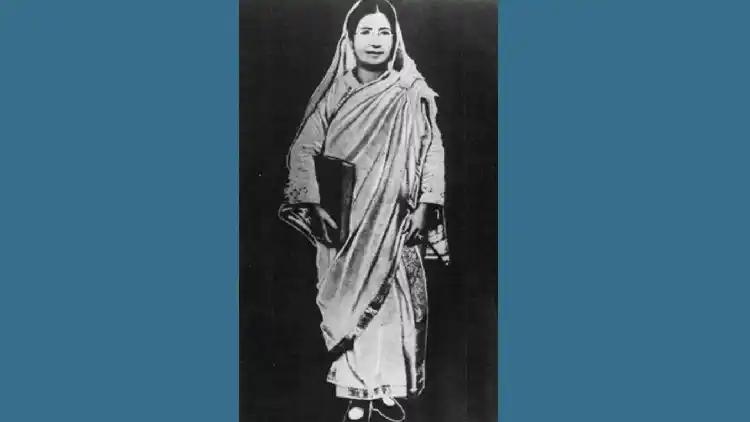
Saquib Salim
Oh, why did I come to this miserable world,
Why was I born in a purdah country!
These are the lines from chapter The Forty seventh, the last, of the Bengali book Avrodhbhasini (The Secluded Ones) by Begum Rokeya Sakhawat Hossain in 1929. The book is a collection of 47 real life anecdotes and exposes the extreme form of confinement women were subjected to in the early 20th century Bengali Muslim society.
Begum Rokeya had established Sakhawat Memorial Girls’ School, one of the earliest schools for Muslim girls, in Kolkata after the death of her husband Syed Sakhawat Hossain. Much before establishing the school in 1911, she wrote in journals to create awareness for the right to education for women. Though she never attended a school, and was taught by elder brother Ibrahim Saber at home, Rokeya understood the importance of education for women. She founded Anjuman-e-Khawatin-e-Islam (Muslim Women’s Association) in 1916 with the purpose of organizing the Muslim women.
As purdah is a topic of discussion after the takeover of Afghanistan by the Taliban, Rokeya’s seminal work The Secluded Ones should be revisited. The book provides an insider’s views as Rokeya wrote about her experiences. Even this day the anecdotes recorded in the book sound unreal making one marvel at the fight of women for the basic rights. Luckily they enjoy these rights, however limited these are.
In the introduction to the book, Rokeya explains the rationale behind using anecdotes rather than writing her own views. She writes:
“FOR A LONG TIME, we have been used to seclusion. Therefore, we — especially myself —had nothing in particular to say against seclusion. If one asks a fisherwoman, “Does rotten fish smell good or bad to you?” how would she answer that?
I am presenting the reports of a few incidents to my sisters for their review—I hope they would find them interesting.”
The most horrific incident mentioned in the book is anecdote number 14. According to Rokeya, in 1907, one of the aunts of her husband was travelling from Patna to Bhagalpur by train. She was accompanied by a maid. At Kiul railway junction, she ‘stumbled against her voluminous burqa and fell on the railway track’.
The men around her tried to help her but the maid would not allow ‘any man’ to touch her mistress because it was against the purdah culture. The maid was unable to drag her and the train passed and killing her.
In another story a woman whose house was on fire could not dare to step outside as ‘unknown men’ were standing outside. She kept on waiting for them to go and in the meanwhile the fire burnt her to death. In another incident a Nawab would not allow the doctor to put a stethoscope at the back of his wife. Health of a woman, and hence life, was secondary to the so-called honour of the family.
The last anecdote is about the school established by Rokeya. In 1925-26, a bus was hired to transport the girl students. According to the social realities of the time, the bus was ‘adequately’ veiled. Curtains and sarees were draped and not a single orifice was left in the bus. The bus was dark from inside with no ventilation.
As expected, the girls started vomiting and fainting after travelling in such a ‘black hole’. When the mothers of the students came to complain, Rokeya asked them if they would allow their girls to go to school without purdah? Interestingly, several men wrote letters to her that the two curtains hanging by the side of the bus moved with the wind, hence the purdah of the bus was not adequate. If the problem was not fixed they would be compelled to launch a public movement against the bus. Rokeya wrote that in such a dilemma she thought;
If I don’t catch the cobra
The King will have my head—
If caught carelessly
Surely the cobra will bite me!
The case made by Rokeya was against the seclusion and not against the dressing of women in any certain fashion. She was against a culture where women are kept away from other men and women, not allowed to receive education and considered inferior.
Rokeya, somewhere else, wrote that Allah had not made women any inferior. The main argument, in those days, made by the orthodoxy against women’s education was that they are not supposed to do a job what was the need of educating them. Rokeya contended:
“The development of the God-given faculties by regular exercise of these faculties. Merely passing an examination and getting a degree does not constitute real education, in our opinion. The point of education is not to get a job. The ultimate purpose of education for human beings, regardless of sex, is self-realization, the fullest development of their potential as human beings. That is why women have as much right as men to education.”
Rokeya, interestingly, always covered her head covered. In her view, coming out of veil could not be equated with emancipation. In several cases women who did not cover themselves were oppressed. She believed that covering the body was ethical and that was the difference between animals and humans. In her view, seclusion of women from education was something against which voice should be raised. A woman who took off her veil under social pressure was no better than a woman who took a veil under a similar social obligation.
Rokeya wanted an end to the discrimination, rather seclusion, against the Muslim women in the society. Her idea of emancipation was grounded into opening up education and having economic independence for women and not into the kind of dress one wore.
(The Writer is a historian and a writer)
